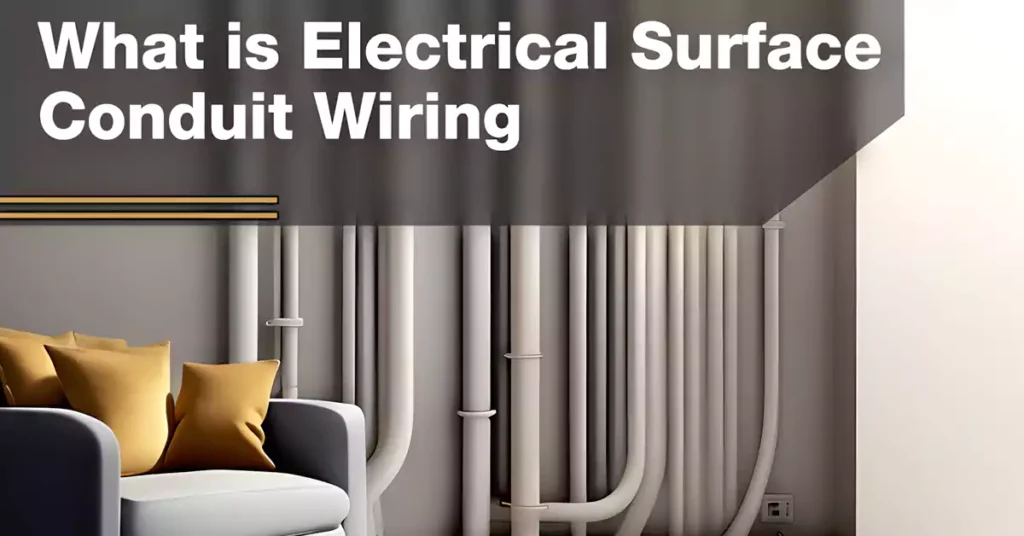
Table of Contents
Electrical surface conduit wiring is a versatile and practical method of installing electrical systems, offering numerous benefits and applications. This comprehensive guide aims to delve into the world of surface conduit wiring, providing an in-depth understanding of its purpose, advantages, installation process, compliance with regulations, maintenance, precautions, and more.
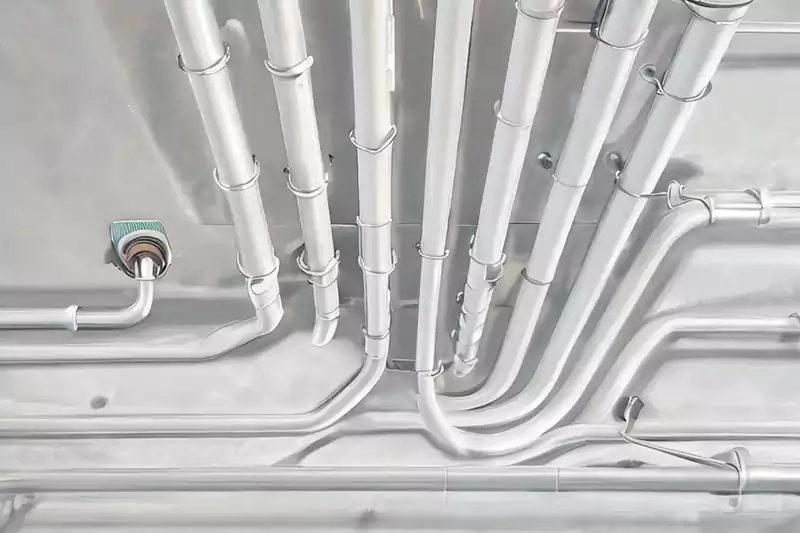
Electrical surface conduit wiring involves the installation of conduits on the surface of walls, ceilings, or other structures to house and protect electrical cables. It provides a safe pathway for electrical wires, ensuring their protection from damage while facilitating easy access for maintenance, modifications, or troubleshooting.
Surface conduit wiring is crucial in situations where conventional concealed wiring is impractical or undesirable. It offers flexibility, accessibility, and protection for electrical cables, making it an ideal choice for residential, commercial, and industrial applications. By understanding the benefits and considerations associated with surface conduit wiring, you can make informed decisions when planning and implementing electrical installations.
Electrical surface conduit wiring offers a range of advantages that make it a preferred choice for various electrical installations. Here are some benefits of it:
Surface conduit wiring provides flexibility in electrical system modifications. Unlike concealed wiring, which requires extensive wall or ceiling alterations, surface conduit allows for easy additions, reconfigurations, or repairs. The conduits can be easily accessed, making it simple to route new cables or modify existing ones as per changing needs.
Surface conduit wiring offers excellent accessibility for troubleshooting and maintenance purposes. As the conduits are visible and accessible on the surface, it becomes easier to identify and rectify electrical issues. Maintenance tasks such as inspecting connections, replacing faulty cables, or making adjustments can be performed swiftly, reducing downtime.
One of the primary functions of surface conduit wiring is to provide robust protection for electrical cables. The conduits shield the cables from potential damage caused by physical impact, moisture, chemicals, or other external factors. This protection ensures the longevity and reliability of the electrical system, even in challenging environments.
Surface conduit wiring offers aesthetic advantages, especially in situations where exposed wiring is preferred or necessary. The conduits can be designed to match the surrounding architecture, and various finishes or paint can be applied to seamlessly blend with the decor. This customization allows for an aesthetically pleasing electrical installation while maintaining functionality.
Surface conduit wiring finds application in diverse settings. It is suitable for residential installations, commercial buildings, industrial facilities, and even outdoor scenarios. Whether it’s for home renovations, office expansions, or outdoor lighting projects, surface conduit wiring offers a versatile solution that can adapt to various requirements.
Surface conduit wiring can often be more cost-effective compared to concealed wiring methods. The ease of installation, accessibility for modifications, and reduced labor and material costs associated with concealed wiring contribute to its cost advantages. Additionally, the durability and protection provided by surface conduit wiring can lead to long-term cost savings by minimizing the need for repairs or replacements.

There are also some disadvantages of surface conduit wiring you need to consider:
Surface conduit wiring may not always seamlessly blend with the aesthetics of a space, especially in areas where a clean and minimalist look is desired.
Surface conduit wiring requires additional space along walls, ceilings, or other surfaces for conduit installation, which can be a concern in areas with limited wall space or where maintaining a clutter-free environment is important.
Surface conduit wiring is visible on the surface, which means it doesn’t offer the advantage of complete concealment like concealed wiring methods.
While surface conduit wiring provides protection, the conduits themselves can be susceptible to damage from impacts or accidental contact, requiring periodic inspections and maintenance.
The presence of surface conduit may restrict the placement of furniture or other objects against the walls, affecting the arrangement and functionality of the space.
By considering both the benefits and disadvantages of surface conduit wiring, you can make informed decisions when determining its suitability for specific electrical installations.
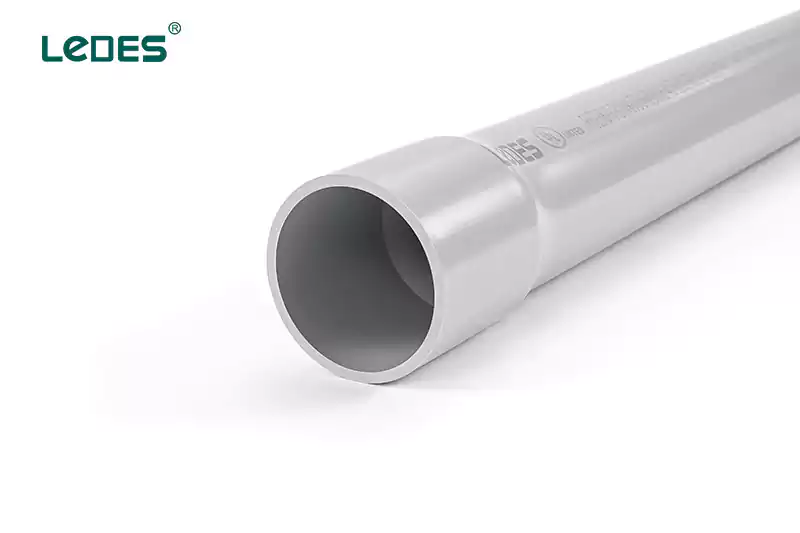
Electrical surface conduit wiring involves several components that work together to create a safe and functional system for housing and protecting electrical cables. Understanding these components is essential for proper installation and maintenance. Here are some key components of surface conduit wiring:
Conduits are hollow tubes used to enclose and protect electrical cables. They are available in various types, materials, and sizes to accommodate different applications. Common conduit materials include metal (such as steel or aluminum) and PVC (Polyvinyl Chloride). The choice of conduit material depends on factors such as the environment, electrical code requirements, and project specifications.
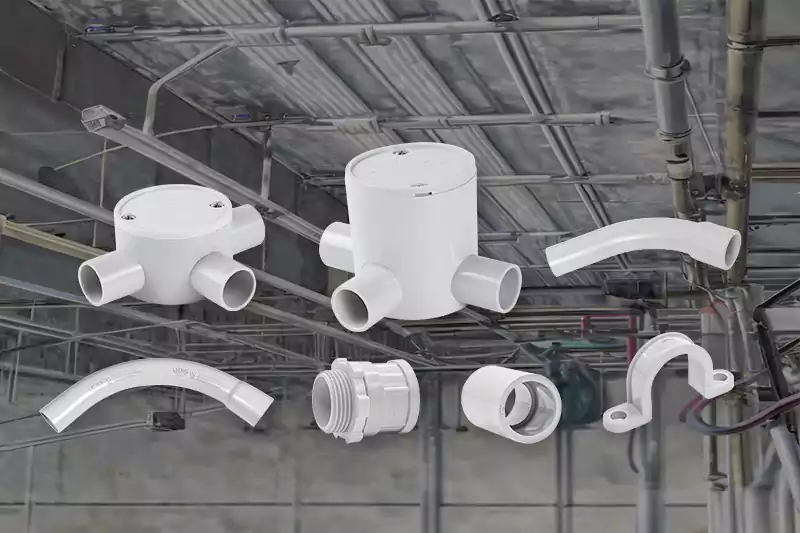
Fittings and connectors are crucial components that facilitate the connection and routing of conduits. They include elbows, couplings, connectors, junction boxes, and conduit straps etc. Fittings ensure secure connections between conduits and provide flexibility in changing directions, joining multiple conduits, or transitioning between different sizes or types of conduits.
Proper mounting and fastening methods ensure the stability and secure placement of conduits on the surface. Mounting options include brackets, clips, straps, hangers, or conduit clamps. These methods vary based on the surface material (e.g., wood, concrete, or metal) and the weight or size of the conduits.
In some situations, surface conduit wiring may require additional support or standoffs to maintain proper clearance from the surface. Supports, such as conduit racks or cable trays, provide structural support and help organize and manage cables. Standoffs, also known as insulators or spacers, create separation between the conduit and the mounting surface, preventing heat buildup and potential damage.
Access points and covers allow for easy access to the conduits and electrical connections for maintenance, inspections, or modifications. These may include conduit bodies, pull boxes, or junction boxes. Covers, such as blank covers or device covers, provide protection and help maintain the integrity of the system.
Grounding and bonding components ensure electrical safety by providing a path for fault currents and preventing electrical hazards. These components include grounding clamps, grounding bushings, grounding conductors, bonding jumpers, and grounding electrodes. Proper grounding and bonding practices are essential for surface conduit wiring installations.
Understanding these components and their functions is crucial for a successful surface conduit wiring installation.
Installing surface conduit wiring involves several steps that ensure a safe and efficient electrical system. Proper planning, preparation, and adherence to electrical codes and regulations are essential. Here are the general steps of surface conduit wiring installation:
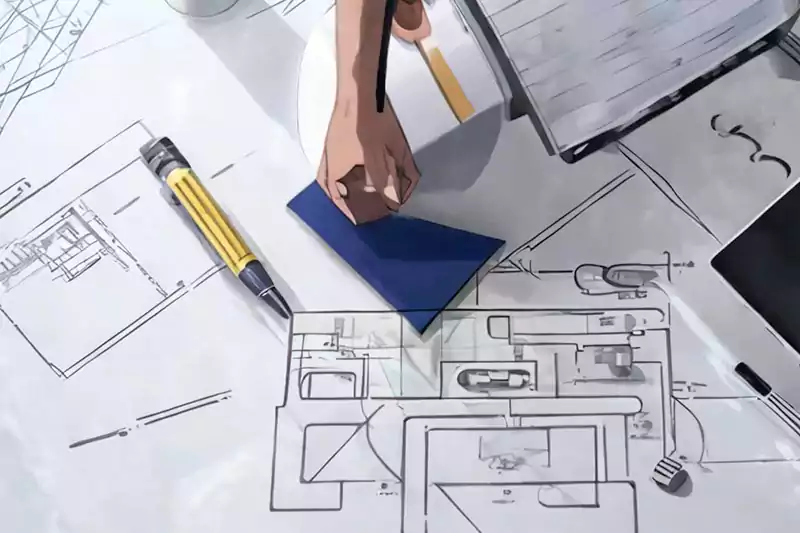
Determine the electrical load, circuitry, and equipment that the surface conduit wiring will support. Consider factors such as voltage, current, and anticipated future needs.
Select the appropriate conduit type and size based on the application, environment, and electrical code requirements. Consider the number and size of cables that will be housed within the conduit.
Plan the routing of conduits and their locations on the surface. Consider accessibility, aesthetics, and any structural or architectural limitations. Mark the locations for conduit mounting points, fittings, access points, and junction boxes.
Ensure you have all the necessary tools and materials, including conduit, fittings, connectors, mounting hardware, fasteners, junction boxes, wiring, and appropriate tools for cutting, measuring, and securing the conduits.
Clean the surface where the conduits will be mounted. Remove any obstructions or obstacles that could interfere with the installation process.
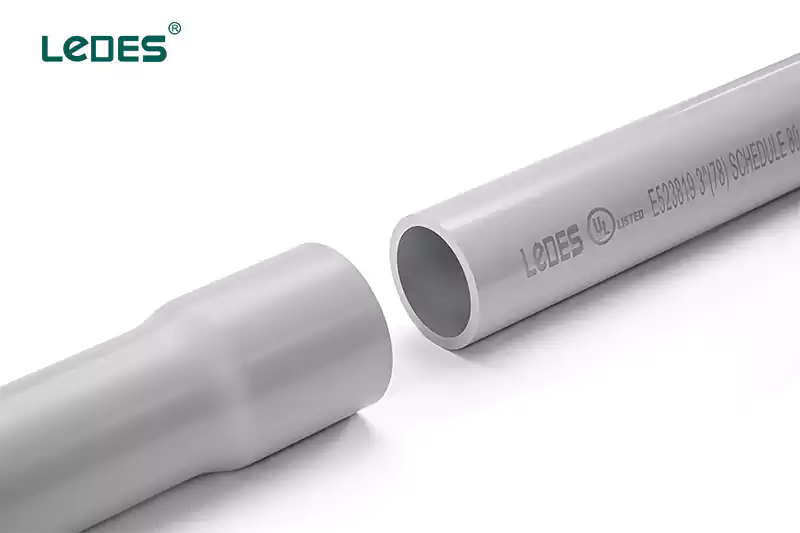
Install conduit mounting hardware, such as brackets, clips, or straps, on the surface. Use appropriate fasteners and ensure proper spacing and alignment.
Begin routing the conduits according to the planned layout. Attach fittings and connectors as needed to change directions or join multiple conduits. Use appropriate couplings or adapters when transitioning between different conduit sizes or materials.
Use conduit supports, racks, or cable trays as necessary to provide additional support and maintain proper clearance. Secure the conduits at regular intervals using appropriate fasteners or straps.
Install access points, such as conduit bodies, pull boxes, or junction boxes, at appropriate locations for easy access to the conduits and electrical connections. Ensure they are properly secured and provide adequate space for wiring and maintenance.
Pull electrical cables through the conduits, ensuring proper sizing and appropriate bending radius. Secure the cables using appropriate cable clamps or ties.
Make electrical connections within the junction boxes or conduit bodies using proper wiring techniques, such as wire nuts, terminal blocks, or crimp connectors. Follow electrical code requirements for grounding and bonding.
Conduct thorough testing to ensure proper electrical connections, continuity, and functionality. Use appropriate testing equipment to verify voltage, insulation resistance, and circuit integrity.
Ensure the installation complies with local electrical codes and regulations. Adhere to guidelines for conduit spacing, support, grounding, bonding, and other relevant requirements.
Take necessary safety precautions throughout the installation process, such as wearing appropriate personal protective equipment (PPE), de-energizing circuits when required, and following safe work practices.
By following these installation steps diligently and ensuring compliance with electrical codes, you can achieve a successful surface conduit wiring installation.
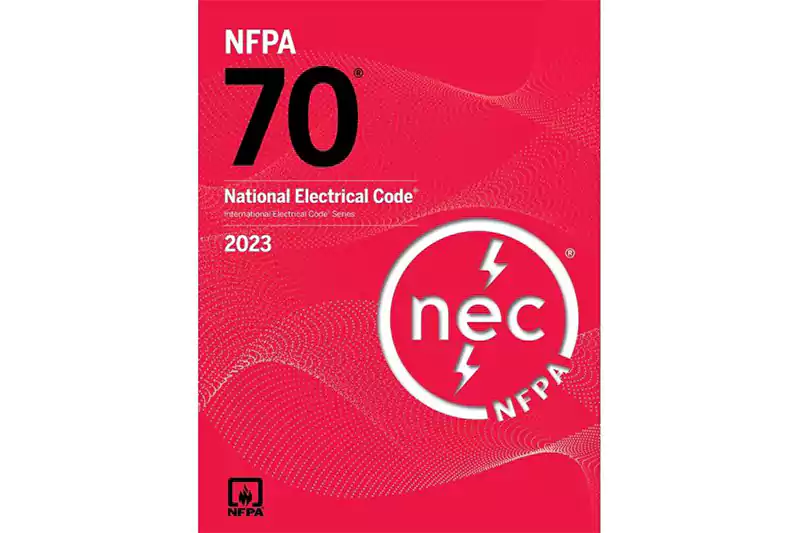
Compliance with electrical codes and regulations is of utmost importance when it comes to electrical installations, including surface conduit wiring. These codes and regulations are established to ensure the safety, efficiency, and reliability of electrical systems.
Local electrical standards are designed to prioritize safety. They include guidelines and requirements that protect against electrical hazards, such as electrical shocks, fires, and equipment damage. Adhering to these standards ensures the safety of individuals using the electrical system.
Compliance with local electrical codes and regulations is often mandated by law. Failure to comply can result in penalties, fines, or legal consequences. It is essential to understand and follow the specific requirements set forth by the local regulatory authorities.
Electrical codes specify the minimum size of conduits based on the number and size of the cables they will contain. Adhering to conduit sizing requirements prevents overcrowding, which can lead to overheating and increased risk of electrical failures.
Electrical codes also define the maximum fill capacity for conduits. This ensures that there is enough space for proper cable installation, allowing for easy pulling, maintenance, and future modifications. Compliance with conduit fill requirements prevents excessive cable congestion and potential damage to the cables.
Electrical codes provide guidelines for the spacing between conduits, taking into account factors such as heat dissipation, accessibility, and maintenance. Proper conduit spacing allows for efficient cable routing and reduces the risk of interference or damage between conduits.
Electrical codes specify the requirements for grounding systems to ensure the safe dissipation of fault currents. Proper grounding protects against electrical shocks and helps stabilize voltage levels. Compliance with grounding requirements is essential for the overall safety and performance of the electrical system.
Bonding involves creating a low-impedance path to connect metal components and ensure electrical continuity. It prevents potential differences and reduces the risk of electrical shocks. Adhering to bonding practices as per electrical codes helps maintain system integrity and safety.
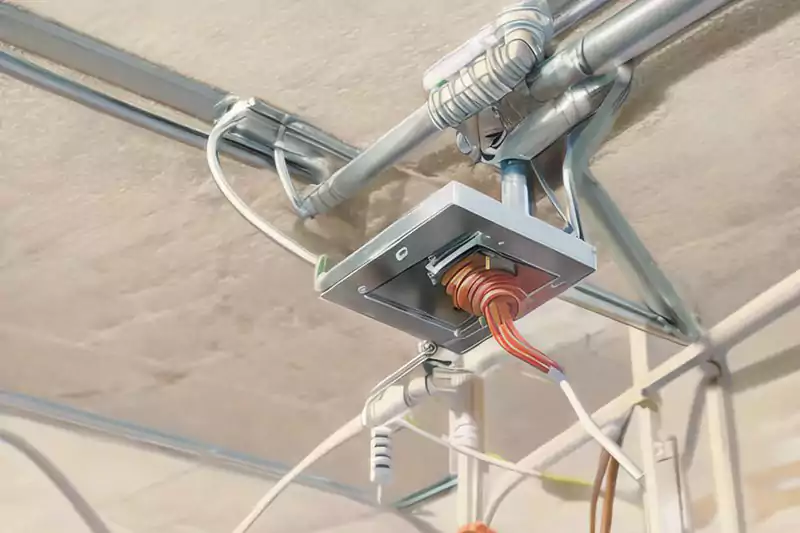
While this method offers flexibility and ease of installation, it is important to take certain precautions to ensure safety and efficiency. Here are some additional safety considerations and precautions to keep in mind during the installation of surface conduit wiring:
It is crucial to select the appropriate conduit size based on the number and size of wires to be installed. This ensures adequate space for wire insertion and prevents overcrowding, which can lead to overheating and potential electrical hazards.
Always de-energize circuits before working on surface conduit wiring. Follow appropriate lockout/tagout procedures and use voltage testers to verify that circuits are de-energized. Use insulated tools and equipment to minimize the risk of electrical shocks. Inspect tools for any damage or wear and replace them if necessary.
The distance between the placement of dowel pins should be determined based on the weight and size of the pipes. This ensures secure attachment and minimizes the risk of conduit movement or dislodgement.
Conduits must be installed at a safe distance from gas and water pipes to avoid any potential interference or damage. This prevents the risk of leaks, contamination, or accidental damage to the electrical system.
Conduits below 16 mm in size should never be used for surface conduit wiring installations, different regions could have different requirements, consulting professionals for installation advice. Using smaller conduits can lead to difficulties in wire installation, increased resistance, and potential overheating.
Ensure proper selection and installation of fire-rated conduits and fittings to meet fire safety requirements. Follow local fire codes and regulations for fire protection in electrical installations.
Not all types of conduit materials is suitable surface wiring, you need to consider the places and conditions of where the wiring is going to be installed. Such as that PVC pipes should not be used in areas where wear and tear or mechanical disruption is possible. It is important to select conduit materials that can withstand the specific environmental conditions and potential impacts in the installation area.
By considering these safety precautions and adhering to best practices during surface conduit wiring installations, you can promote a safe and efficient electrical system. It is essential to consult local electrical codes and regulations and engage qualified professionals to ensure compliance and minimize potential risks.
Surface conduit wiring offers a practical and versatile solution for electrical installations in various residential, commercial, and industrial settings. Its flexibility, ease of installation, and accessibility make it suitable for a wide range of applications.
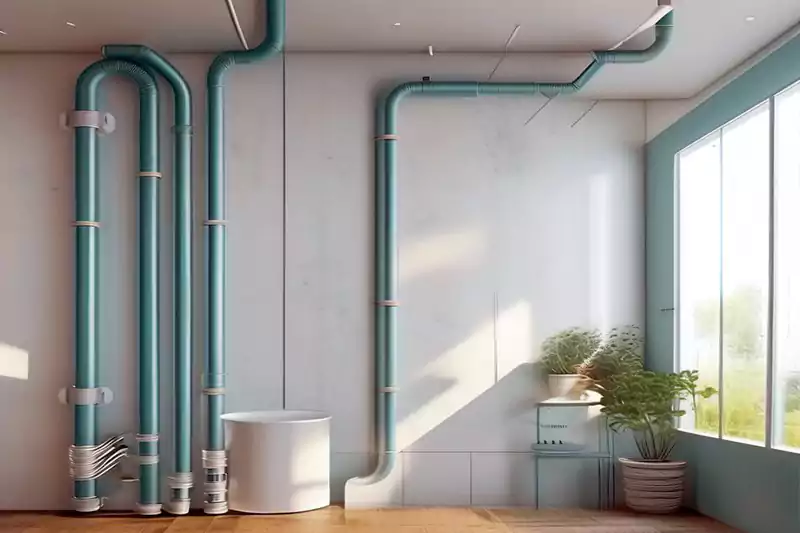
Surface conduit wiring finds widespread use in residential buildings for both new constructions and renovations. It provides a convenient method for routing electrical circuits in homes, apartments, and condominiums. Common applications include:
Surface conduit wiring allows for the installation of power outlets, switches, and lighting fixtures throughout the living spaces, ensuring reliable electrical connectivity.
Surface conduit wiring is often employed in kitchens and bathrooms to power appliances, lighting, and ventilation systems. Its flexibility enables easy integration with cabinetry and wall-mounted fixtures.
Surface conduit wiring provides a safe and accessible solution for powering outdoor lighting, security systems, and other electrical needs.
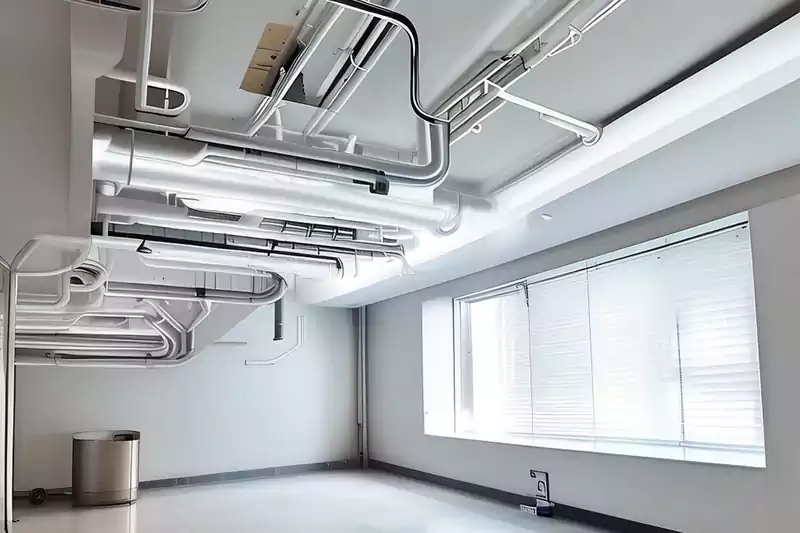
Surface conduit wiring is extensively used in commercial buildings, such as offices, retail stores, restaurants, and educational institutions. Its adaptability and ease of installation make it suitable for various applications, including:
Surface conduit wiring allows for efficient distribution of power and data cabling, accommodating the electrical needs of workstations, conference rooms, and common areas.
Surface conduit wiring provides a flexible solution for powering display lighting, point-of-sale systems, and other electrical equipment in retail settings.
Surface conduit wiring is commonly employed in schools and universities to facilitate electrical connections for classroom lighting, audiovisual equipment, and computer labs.

Surface conduit wiring is widely used in industrial and manufacturing environments, where durability, accessibility, and adaptability are essential. It enables effective power distribution and equipment connectivity, serving applications such as:
Surface conduit wiring allows for the installation of high-intensity lighting systems to ensure proper illumination in large industrial spaces.
Surface conduit wiring provides the necessary electrical connections for heavy machinery, motors, and control panels, ensuring efficient operation and equipment safety.
Surface conduit wiring facilitates the integration of electrical components, such as sensors, actuators, and control devices, enabling reliable process control and automation systems.

Surface conduit wiring is well-suited for temporary installations, construction sites, and event venues. Its versatility and ease of removal make it an ideal solution for powering temporary structures, outdoor events, and exhibitions.
Surface conduit wiring allows for convenient and temporary electrical connections during the construction phase, providing power for tools, lighting, and temporary facilities.
Surface conduit wiring can be easily deployed to supply power for stages, food stalls, lighting, and audiovisual equipment at concerts, festivals, and other outdoor events.
These are just a few examples of the many applications where surface conduit wiring is utilized. Its flexibility, durability, and adherence to electrical codes and regulations make it a reliable choice for various electrical installations across different settings.
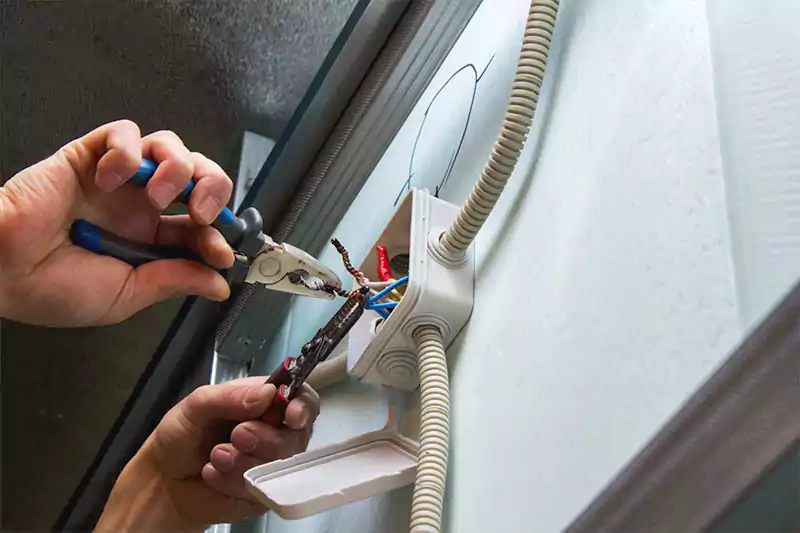
To ensure the continued safety and optimal performance of surface conduit wiring systems, regular maintenance and prompt troubleshooting are essential. Proper maintenance helps identify and rectify potential issues before they escalate, while effective troubleshooting allows for timely resolution of electrical problems.
Regular inspections and preventive maintenance are vital for ensuring the safety and efficiency of surface conduit wiring systems. Here are key steps to follow:
Conduct visual inspections of the conduits, fittings, and wiring to identify any visible signs of wear, damage, or loose connections. Look for cracks, breaks, or corrosion that can compromise the integrity of the system.
Ensure that the conduits and fittings are securely mounted and properly supported. Check for signs of sagging, excessive bending, or detachment. Reinforce and tighten mounting brackets if necessary.
Inspect the cables for any signs of fraying, insulation damage, or exposed wires. Look for proper cable routing and clearance from sharp edges or potential sources of mechanical stress.
Verify the effectiveness of grounding and bonding connections. Ensure that all connections are secure, corrosion-free, and properly installed to provide electrical safety and prevent potential faults.
Regularly clean the surface conduits, fittings, and junction boxes to remove dust, dirt, and debris. Maintain proper airflow and cooling to prevent overheating issues.
Promptly identifying and addressing common issues with surface conduit wiring systems is crucial for maintaining their reliability. Here are some common issues and their corresponding solutions:
Check for loose connections, damaged wires, or overloaded circuits. Tighten connections, replace faulty components, or redistribute the load to resolve the issue.
Identify the cause of the circuit overload, such as excessive power consumption or a short circuit. Remove or replace the faulty equipment and redistribute the load if needed.
Inspect for signs of insulation damage, such as exposed wires or frayed cables. Replace damaged insulation promptly to prevent electrical hazards and ensure proper insulation resistance.
Address any corrosion or moisture-related problems by applying appropriate coatings or treatments. Replace corroded conduits, fittings, or components to maintain system integrity.
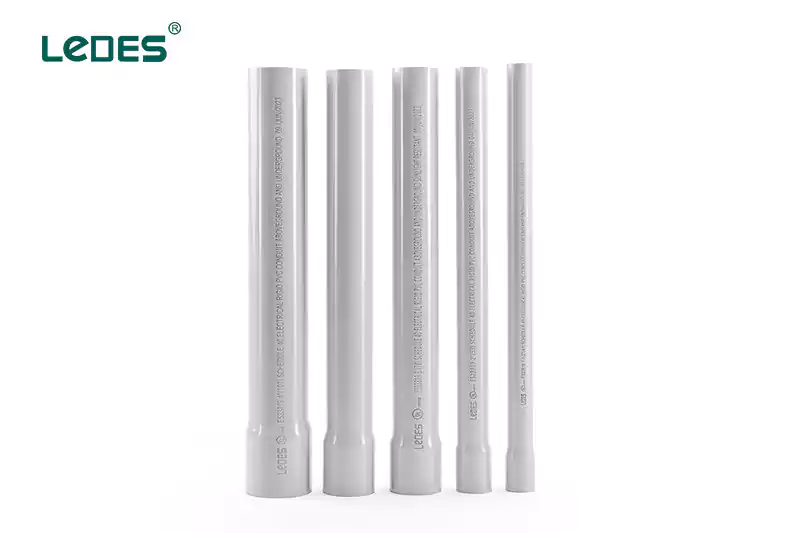
When performing repairs or modifications on surface conduit wiring systems, it is essential to follow safe practices to minimize risks. Consider the following guidelines:
Always de-energize the circuits before starting any repair or modification work. Use appropriate lockout/tagout procedures and test for electrical power to ensure circuits are properly de-energized.
Wear suitable PPE, including insulated gloves, safety glasses, and protective clothing, to protect against electrical shocks, arc flashes, and other potential hazards.
Use appropriate tools and equipment for the task at hand. Insulated tools and voltage testers help prevent accidental electrical contact and ensure accurate measurements.
Maintain a clean and organized work area, free from clutter and potential hazards. Securely support conduits and components during repairs or modifications to prevent accidental dislodgment.
Adhere to local electrical codes and regulations when making repairs or modifications. Ensure compliance with wiring standards, grounding requirements, and load capacity guidelines.
Keep detailed records of repairs, modifications, and maintenance performed on the surface conduit wiring system. This documentation can aid in future troubleshooting and maintenance efforts.
By conducting regular inspections, addressing common issues promptly, and following safe practices during repairs and modifications, you can ensure the longevity, safety, and optimal performance of surface conduit wiring systems.
When it comes to electrical installations, different wiring methods are available, each with its advantages and suitability for specific applications.
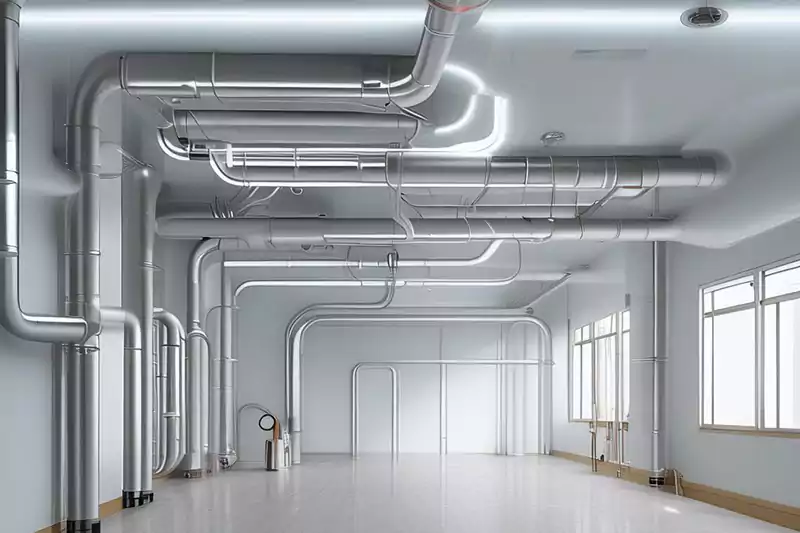
Surface conduit wiring is relatively easier and quicker to install compared to concealed conduit wiring. It involves mounting conduits on the surface of walls or ceilings, making it more accessible for modifications or repairs. Concealed conduit wiring requires embedding conduits within walls or ceilings during construction or renovation.
Surface conduit wiring offers greater flexibility in routing circuits and allows for easy access to the wiring system. Concealed conduit wiring, while providing a cleaner aesthetic appearance, can be more challenging to modify or repair due to the need for wall or ceiling access.
Surface conduit wiring simplifies maintenance and troubleshooting as the wiring is readily visible and accessible. In concealed conduit wiring, identifying and rectifying issues may require more effort and potentially involve opening up walls or ceilings.
Concealed conduit wiring provides a neater and more aesthetically pleasing appearance as the wiring is hidden within walls or ceilings. Surface conduit wiring, on the other hand, is visible and may be considered less visually appealing but can be utilized as a design element in certain applications.
Cable trays or raceways are primarily used for managing and supporting large bundles of cables or wires. They offer superior cable organization and allow for easy additions or removals. Surface conduit wiring is better suited for individual or smaller groups of cables.
Cable trays or raceways provide more flexibility in terms of cable routing and can accommodate cables of various sizes and types. Surface conduit wiring has limitations in terms of the number and size of cables it can accommodate.
Cable trays or raceways offer better protection for cables against physical damage, such as crushing or impact. Surface conduit wiring provides moderate protection but may be more susceptible to damage in certain environments.
Surface conduit wiring is generally more cost-effective compared to the installation of cable trays or raceways, especially for smaller-scale applications.
The choice between surface conduit wiring, concealed conduit wiring, or cable trays/raceways depends on several factors:
The type of building structure, whether it’s new construction or a renovation, influences the feasibility and practicality of different wiring methods.
Consider the need for easy access to the wiring system for maintenance, modifications, or future expansions.
The desired visual appearance and architectural design preferences of the space may play a role in selecting the appropriate wiring method.
Project timelines and deadlines may influence the choice of wiring method, as surface conduit wiring generally requires less installation time compared to concealed conduit wiring.
Consider the quantity and type of cables to be installed, as well as the requirements for cable organization and future scalability.
Cost considerations, including material costs, labor expenses, and long-term maintenance requirements, can impact the choice of wiring method.
It’s important to assess these factors and consult with electrical professionals to determine the most suitable wiring method for a specific application, considering factors such as safety, functionality, aesthetics, and budgetary constraints.
Surface conduit wiring continues to be relevant and widely used in modern electrical installations. Its flexibility, accessibility, and ease of installation make it a practical choice for a variety of applications. While concealed conduit wiring and cable trays/raceways have their advantages in specific scenarios, surface conduit wiring offers unique benefits that align with the needs of many projects.
As technology evolves and electrical systems become more complex, the relevance of surface conduit wiring persists. From residential buildings to commercial spaces, surface conduit wiring provides a reliable and accessible solution for a wide range of electrical installations.
In conclusion, surface conduit wiring offers a practical, cost-effective, and durable wiring method, allowing for flexibility, accessibility, and ease of maintenance. When implemented following electrical codes and best practices, it ensures the longevity, safety, and optimal performance of electrical systems in various applications.
That’s it. If you still have any questions, you can contact us by contact form or click here to send us an email today.



